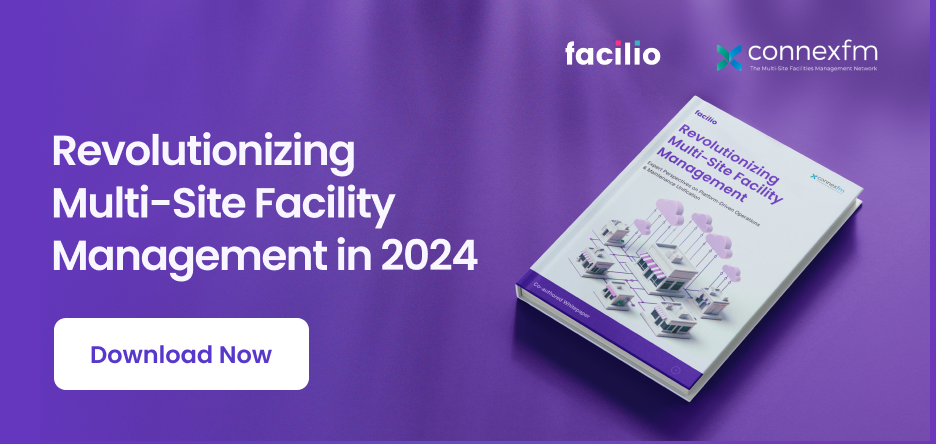Future of Retail
Navigating the Shifting Landscape of Retail FM

In the dynamic world of retail, facility management (FM) has emerged as a critical component ensuring seamless operations across diverse stores and locations.
Facility managers find themselves at a crossroads, grappling with challenges that demand immediate attention and strategic innovation.
We confront the stark reality that the traditional ways of managing multi-site facilities are no longer sufficient. Once characterized by routine tasks and reactive approaches, the sector is now caught in a whirlwind of change.
Skilled labor shortages, slimming profit margins, escalating operating costs, and the urgency to meet compliance standards have created a perfect storm, necessitating a paradigm shift in how multi-site FMs approach their craft.
The last thing facility managers need is a technology ecosystem that hinders rather than aids. Let's dive deeper to see why this mismatch between priorities and realities exists and what can be done about it.
Evolving operational realities vs. priorities for multi-site FMs
The retail FM industry is experiencing a seismic shift driven by several macro trends that significantly impact operational priorities. Traditionally, facility managers were adept at solving recurring problems, but today, they find themselves trapped in a cycle of reactive approaches. Contributing factors include:
Skilled Labor Shortages: A pressing challenge for FM professionals is the scarcity of skilled trades. The waning interest in critical manual and technical roles has led to a lasting labor shortage, forcing organizations to optimize limited skilled labor and address associated high costs.
Energy Efficiency: Rising energy costs, evolving consumer demands, and stringent compliance rules pose challenges for FM teams striving to balance comfort and cost-effective energy usage.
Disconnected Solutions: The pursuit of technology-driven solutions has resulted in an unintended chaos of disconnected point solutions. Numerous software applications focused on specific tasks have created fragmentation, hindering real-time visibility and alignment of strategies.
Segment-specific Challenges: Each sector within retail faces distinct challenges, from minimizing food loss and navigating compliance in grocery stores to reducing unplanned maintenance and service call volumes in other retail formats. Existing FM software often falls short, offering one-size-fits-none solutions that hamper growth and productivity.
The result looks something like this:
- Technicians grapple with multiple work orders, juggling eight different apps, which hinders efficiency and first-fix rates.
- Store staff struggle with dealing with constant system alarms that divert attention from revenue activities. Distinguishing between critical facility alarms and routine disruptions becomes challenging.
- Internal teams responsible for end-to-end visibility encounter challenges reconciling various operational aspects, including maintenance, processes, payments, inventory, system performance, and budget management.
Breaking the status quo and reimagining what’s possible
Maintenance, once viewed as a cost center, is quickly becoming a revenue-generation mechanism. FM teams want to shift from firefighting to strategic contributors, but the software they are stuck with isn’t helping them make this transition.
The “why to fix something that ain’t broken” mindset means we never really break out of the status quo, which in turn means real and transformational change will never happen.
FM professionals excel at solving recurring problems but are trapped in a cycle of reactive approaches. The rapid pace of multi-site operations exacerbates this, hindering holistic problem-solving.
Key FM modules operate in isolation, necessitating manual consolidation for reporting, impeding effective communication and insights at an enterprise level. The siloed nature of FM systems impedes a proactive, holistic, and unified approach to the technology stack. The solution begins with reimagining what’s possible.
From shadows to strategic partners: Elevating the role of FMs
The art of the possible in FM extends beyond problem-solving to encompass broader organizational objectives like sustainability. Achieving this ambitious end goal demands the seamless integration of disparate FM modules.
By fostering cohesion among these elements, FM professionals can elevate their roles from reactive firefighting to strategic contributors, delivering comprehensive sustainability metrics that align with overarching organizational initiatives.
A grocery chain in the UK allocated a 32-member team to monitor alarm traffic across 1800 stores. Transitioning to a more automated solution freed up these resources, redirecting them toward more crucial tasks and illustrating the potential for efficiency gains.
Crawl, walk, and run - Enabling FM growth with platforms
Facility management growth is simplified through a phased approach—crawl, walk, and run—enabled by a unified platform. Unlike dealing with various standalone solutions, a unified platform integrates everything into a single system.
Transition seamlessly from basic monitoring to advanced predictive measures or add control features alongside maintenance. These shifts happen effortlessly on a platform because they share the same foundation.
Agile compliance at scale with data at the helm
Compliance is critical, especially for multi-site FMs facing the challenge of staying abreast of fast-changing local, state, and federal regulations across geographies.
Take, for instance, the monthly compliance checks inherent in the grocery retail sector. Traditionally managed on paper, deciphering compliance status across many stores has been challenging for maintenance teams with limited resources. However, the implementation of a unified platform transforms this process.
A unified platform becomes a centralized hub for compliance data, transforming preventative maintenance. Compliance is no longer a burden; it becomes an integral part of operational excellence through continuous commissioning and the ability to control setpoints during demand response events.
In conclusion, navigating retail FM managers' challenges requires a strategic approach grounded in education, collaboration, and agility. By embracing innovative solutions and prioritizing continuous improvement, retail FM managers can position themselves for success in an increasingly competitive marketplace.
Get all the details + actionable tips to relook at your operations game with our latest whitepaper!



